Lettuce is a crispy, green, and lush vegetable with great taste and vitamin content. Lettuce plants can thrive in raised beds because the open soil structure suits them. But the correct spacing makes a lot of difference.
Space the loose lettuce variety 2-4 inches apart. When planted in rows, space them 1 inch apart and the rows 8 -10 inches apart. Space the crisp head variety 12-18 inches apart. In rows, space 6-12 inches apart and rows 18 inches apart. And space the butter lettuce variety 6-8 inches apart.
This guide will discuss how far apart you should plant lettuce in raised beds. I will also provide guidelines for growing this amazing crop and the mistakes you must avoid while growing them in a raised bed.
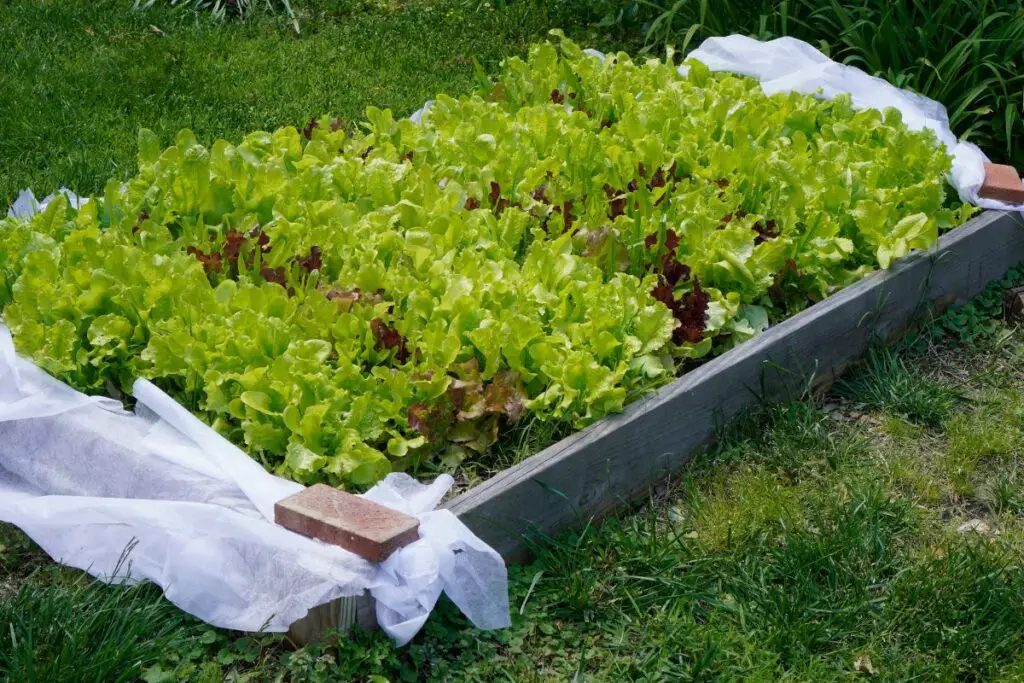
Why is it important to properly space lettuce plants?
Correct spacing of the lettuce plants is important due to the following reason.
Higher production
When the lettuce plants are properly spaced, they will get plenty of sunlight, water, and nutrients from the soil in adequate some amount.
Hence, they will utilize these resources to their full potential, leading to higher production.
Lower risk of diseases
Overcrowded lettuce plants become more susceptible to pests and diseases.
The air circulation around the plants reduces, so the moisture trapped in the leaves will take longer to dry out.
This situation will create a favorable climate for pests and diseases to attack the plants.
In a very short period, your whole garden can get infected with pests, so it’s important to space the plants adequately.
Ease in harvesting
When lettuce plants are properly spaced, it becomes very easy to get in between the rows and harvest the vegetable.
Which variety of lettuce grows best in raised beds?
Taste and space are the most important consideration when determining the lettuce variety to be grown in raised beds.
We need to choose those varieties that will give the maximum yield with good taste in the smallest space.
Most lettuce varieties are suitable for raised beds, and the selection can be overwhelming.
We can choose any variety as per our choice; however, the compact variety will be the most suitable choice for raised beds.
I recommend you grow loosehead, iceberg, romaine, and butter lettuce in raised garden beds.
These varieties can grow in a small space, making them suitable for raised bed gardening.
Looking for gardening supplies? We have tested 100's of products before recommending them to you guys. Check out our best pick below:
| Image | Gardening Supplies | Best Price? |
|---|---|---|
 Top
Top Top
Top | Raised Garden Bed Kit | Check On Amazon |
 | XLUX Soil Moisture Meter, Plant Water Monitor, Soil Hygrometer Sensor for Gardening, Farming, Indoor and Outdoor Plants, No Batteries Required | No Results |
 Top
Top Top
Top | 82 Pcs Garden Tools Set and Extra Succulent Tools Set | Check On Amazon |
 | Joeys Garden Expandable Garden Hose with 8 Function Hose Nozzle, Lightweight Anti-Kink Flexible Garden Hoses, Extra Strength Fabric with Double Latex Core, (50 FT, Black) | No Results |
 Top
Top Top
Top | Dual Chamber Compost Tumbler | Check On Amazon |
 Top
Top Top
Top | Sunnyglade Plant Stakes | Check On Amazon |
 Top
Top Top
Top | Organic Cold Pressed Neem Seed Oil | Check On Amazon |
 Top
Top Top
Top | Mighty Mint Gallon :-Insect and Pest Control Peppermint Oil | Check On Amazon |
 Top
Top Top
Top | Scotts DiseaseEx Lawn Fungicide | Check On Amazon |
 Top
Top Top
Top | Jacks Classic 20-20-20 All Purpose Fertilizer | Check On Amazon |
 Top
Top Top
Top | 30,000 Seeds Pollinator Attracting Wildflower Mixture | Check On Amazon |
 Top
Top Top
Top | Survival Vegetable Seeds Garden Kit-Over 16,000 Seeds | Check On Amazon |
How should you space lettuce in a raised garden bed?
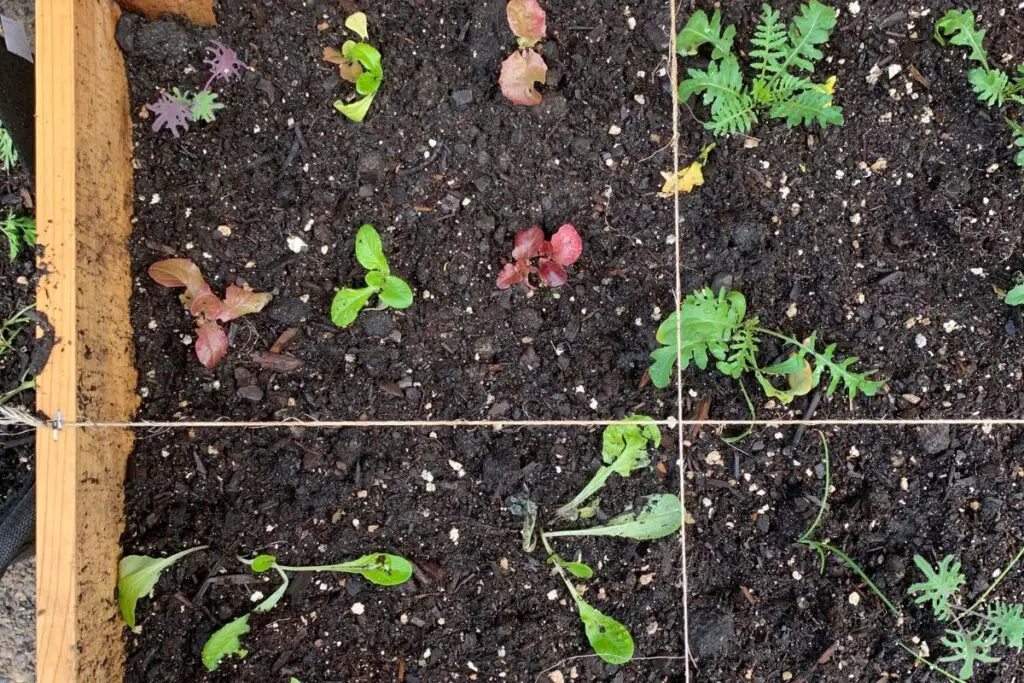
How far apart you should space the lettuce variety in raised beds will depend on the variety you want to grow.
The lettuce plants should be spaced 6 to 12 inches apart, depending on the variety.
When it comes to spacing lettuce plants, it is somehow tricky since lettuce comes in many options.
Each variety of lettuce, from baby green to heading varieties, will be spaced differently.
For example, the leaf lettuce varieties like little Caesar and bibb should be spaced closely, whereas the open head variety, like the iceberg, should be widely spaced.
The lettuce with a longer growing season will require more than those with a smaller growing season.
Let us now discuss the spacing requirements for the popular variety of lettuce in raised beds.
Loose lettuce variety
The loose lettuce variety is only spaced once during its lifetime when transplanted.
It is because the plants are harvested when they are very young.
So, many growers need to consider the idea of thinning their loose lettuce plants and spacing the plant again.
The spacing for the loosehead seedlings should be 2 to 4 inches apart.
If planted in rows, you need to space the lettuce 1 inch apart and the rows 8 to 10 inches apart.
The general guidelines state that growing lettuce in rows is 10 plants per foot.
Crisphead lettuce
The crisphead lettuce variety, like the iceberg or the romaine, is one of the most difficult varieties to grow, taking up more space than other lettuce varieties.
These varieties also have the longest growing season.
They need great care and attention to produce healthy, mild-tasting lettuce heads.
The spacing for each variety of the crisphead will be different, so check the pack of the seeds for the spacing information.
The crisped lettuce should be spaced 10 inches apart as a general guideline.
Some varieties require 18 inches of spacing, while others only need 8 inches.
If you own a crisphead lettuce variety, I recommend you space them 12 to 18 inches apart.
If planted in rows, you need to space the lettuce 6 to 12 inches apart and the rows 18 inches apart.
This spacing will give the plants the ideal growing space and form large, healthy lettuce.
Butter lettuce
The butter lettuce will give rise to a semi-firm head if you adequately space them.
The butter lettuce can also grow well in a compact space, therefore, well suitable for a small raised garden bed.
If you want to make them grow and get a bigger head, you need to space them 6 to 8 inches apart.
If you are planting them in rows, you need to space the seedlings 6 inches apart and the rows 10 to 18 inches apart.
Should I grow lettuce from seeds or transplants in a raised bed?
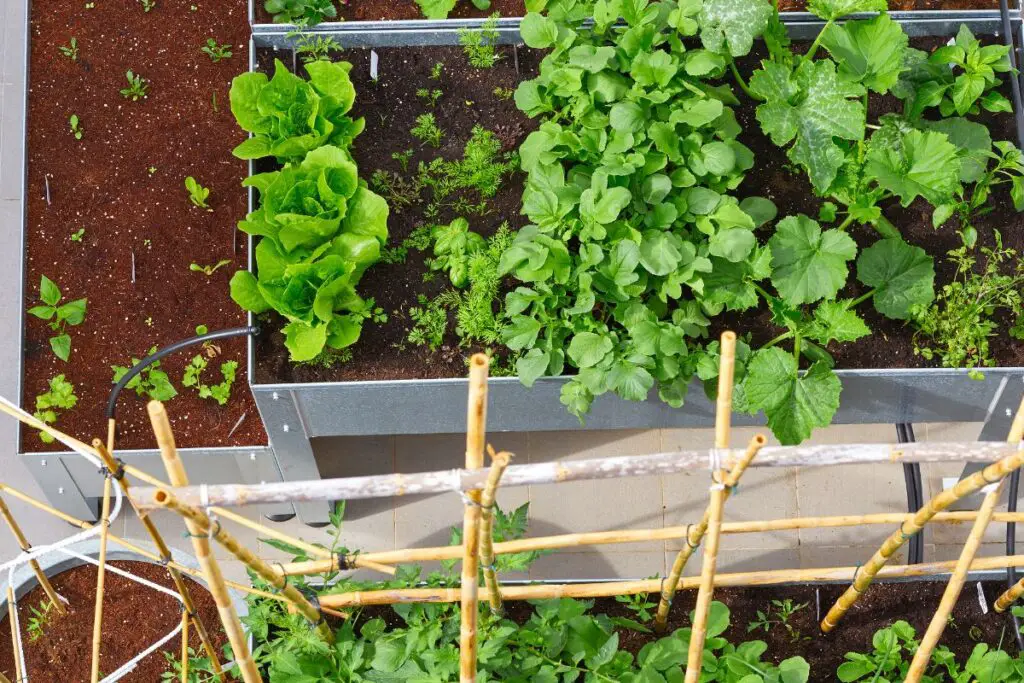
Growing lettuce through transplants makes it easier to space them.
You only need to space the seedlings once when you transplant them.
The lettuce grown by transplant will mature in a very less time and will be ready for harvest.
But if you grow lettuce from seeds, you can’t directly space them in the raised bed.
The lettuce seeds are very small, so you can space them 1 cm while sowing until they become seedlings.
Once they grow about an inch, you must thin them out to the desired spacing.
You can either sow the seeds in a seed tray or directly in the raised bed as per your choice.
Lettuce from seeds will take more time to grow than transplants, so you must keep patience until they grow and mature.
How do you space the lettuce seedlings after thinning them out?
When the seedling emerges from the seeds, you need to thin them out by about 8 cm to 12 cm depending on the variety.
For the larger varieties, like an iceberg, you need to space the seedling 12 inches apart.
In contrast, for the smaller varieties like butterhead and romaine, you need to space the seedlings 6 to 8 inches apart.
If you notice that the lettuce is touching each other, then you can thin out every other lettuce.
The newly thinned lettuce will be sweet and tender, so you can eat it instead of throwing them.
When you thin out the seedlings, snip the excess seedlings that you don’t need with the help of sharp scissors.
If you are planting seedlings in more than one row, leave a minimum 12 inches gap between the rows to have enough room for walking between the rows.
Mistakes you should avoid while growing lettuce in raised beds
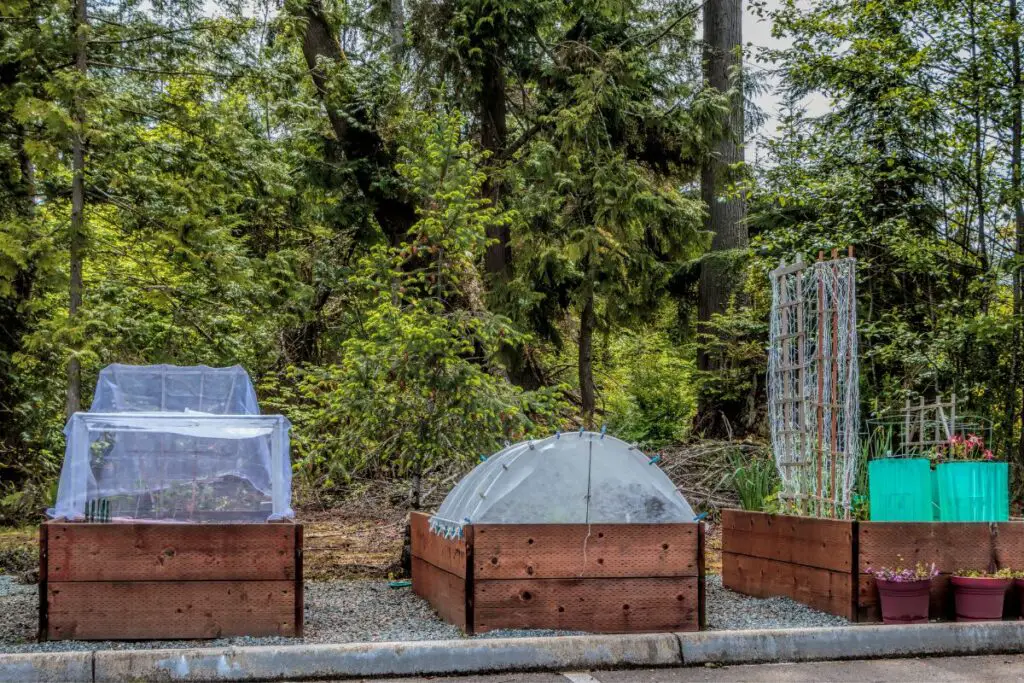
Lettuce is a less demanding crop that makes them a worthwhile vegetable to grow.
All the popular varieties of lettuce require similar growing conditions.
The plants will grow extremely well If you use well-drained soil rich in nutrients.
They will also need a good supply of water throughout their growing season.
Providing the plants will consistently reward you with a gift of healthy, tasty, green leafy vegetables.
To ensure a good harvest, you must avoid the mistakes I have discussed below.
1. Using a wrong soil
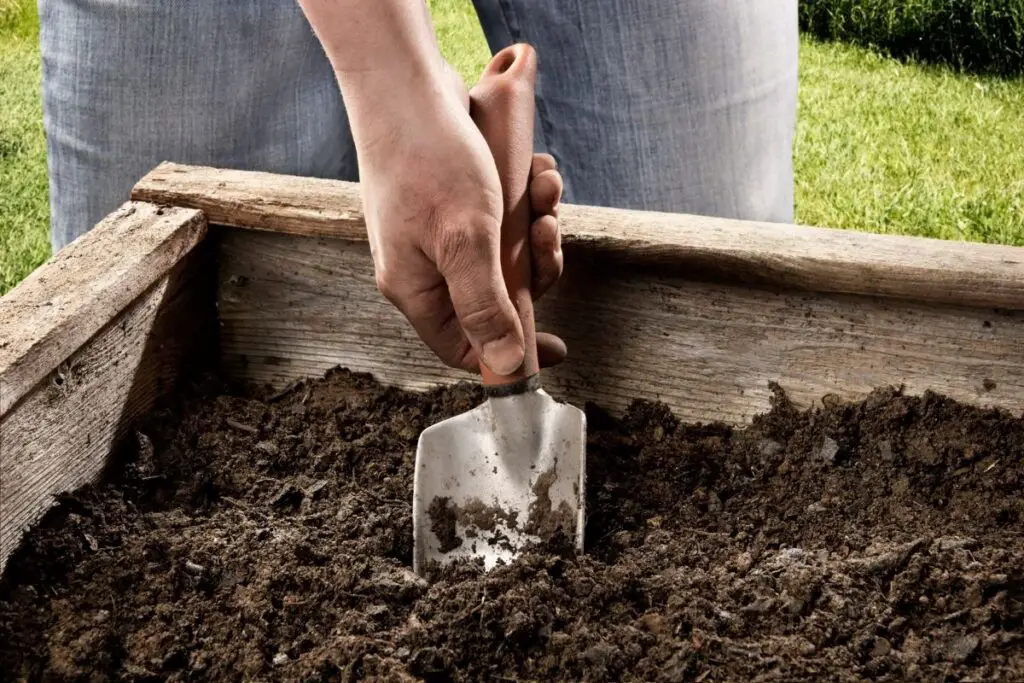
The lettuce will grow best in well-drained sandy or loamy soil.
The soil should be slightly acidic, with a pH balance of 6.0 to 6.5.
Planting the lettuce without checking the soil acidity might give poor results when cultivating the vegetables.
Consider doing a soil test since it has many benefits.
The test will help you verify whether the soil has ideal properties for growing the lettuce plants.
A soil test can determine the soil acidity, nutrient, and moisture content.
It will help you to ascertain what extra things your soil needs and if it could be better for the lettuce.
Also read: 7 Best DIY Raised Bed Soil Mix: A Step-by-step Guide
2. Fertilizing the lettuce plants inappropriately
Fertilizing the lettuce is crucial to get the ideal nutrients for healthy growth.
Your soil might have much more nutrients that your lettuce plants don’t need.
In such a situation, adding fertilizers will harm the roots of the plants.
Also, if you have already added organic compost to the soil, avoid adding any additional chemical fertilizer.
Lettuce usually doesn’t need fertilizers during the growing season, and amending the soil before planting is enough for them to get nutrients.
3. Not mulching the raised bed enough
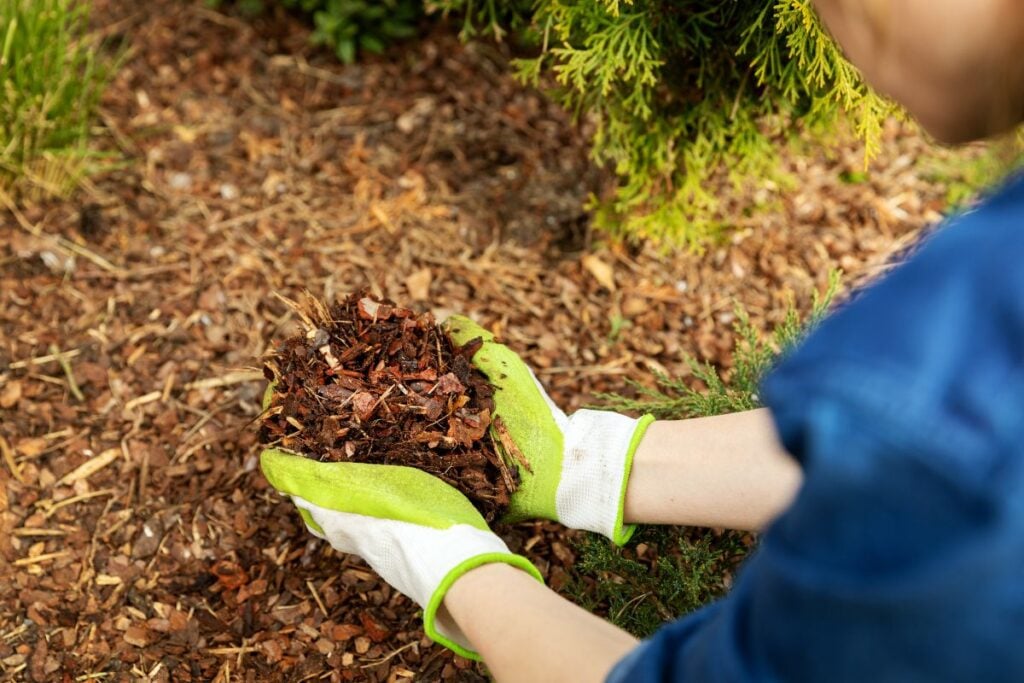
Mulching is an excellent way to help your lettuce thrive at its full potential.
It will help the soil retain moisture by preventing water loss through evaporation.
Not mulching the lettuce plants enough will increase their watering requirements as the moisture will evaporate quickly.
In such conditions, they will dehydrate if you fail to water the plants.
Therefore, always mulch the soil to avoid such problems.
Also read: Can You Put Mulch In A Raised Garden Bed? (Best Mulch+What To Avoid)
4. Watering the lettuce plants too much
Many of us think that the deep watering method works for every crop. However, lettuce is different.
They have shallow roots, can’t handle so much water at a time, and will start suffering from overwatering issues.
Overwatering will make the soil soggy and suffocate the plants’ roots leading to root rot disease.
To prevent this mistake, you can mulch the soil, as this will help the plant retain moisture, and you won’t need to water the plant frequently.
You can also practice shallow watering the plants, as in this way, the soil will stay moist but won’t get soggy.
5. Exposing the lettuce plants to too much light
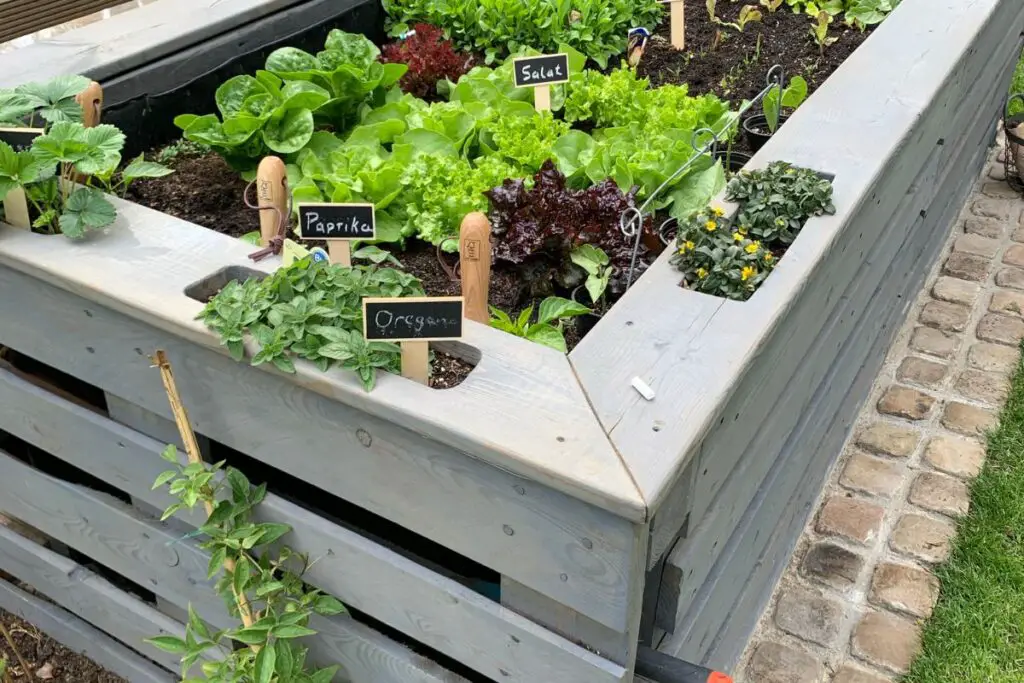
Lettuce plants need a fair amount of sunlight to carry out growth functions.
But it doesn’t mean you will expose them to direct sunlight for an extended period without giving them any protection.
Too much direct light will dehydrate the plants and will cause them to wilt.
Therefore, you must take the necessary measures to protect them on the hottest days of the summer.
You can use nylon netting or a screen to cover the plants.
6. Planting the lettuce at a wrong time
Lettuce plants are cool-weather crops, and planting them during the wrong time of the year will result in a good harvest.
In most cases, the lettuce seeds will only germinate when the soil temperature is around 70°F.
If you live in very hot plants, don’t get discouraged since you can germinate the seeds indoors and transplants the seedlings in a shadier spot of your raised garden bed.
7. Ignoring the pests and diseases
Keeping an eye on many plants with various needs in the raised bed is challenging.
The plants may have pests and diseases that we don’t see.
Therefore, it’s important to take a walk every day in the garden to check for pests.
Not only will it help you find the pests, but you might also notice other potential issues.
Pests like aphids, snails, slugs, armyworms, and birds are common to lettuce.
You can treat the pests with an insecticide.
However, you might need to cover the crop with a net to protect them from birds.
When it comes to diseases, it isn’t easy to treat plants.
Fungal diseases can be treated with fungicides, but there is no cure for viruses.
Make sure there is good airflow around the plants and ensure proper drainage to prevent pests and diseases.
8. Spacing the plants incorrectly
We already know that different lettuce plants have different spacing requirements.
For instance, if you space the open lettuce variety very closely, it takes longer to produce because it can’t grow in very little space.
So, to avoid this type of mistake, always read the information about what kind of lettuce you want to grow in your raised bed.
The spacing between each plant will help the plants produce a good harvest.
Reference: ScienceDirect, American Society of Agronomy, Noble Research Institute, Soil for Raised Beds, Raised Bed Gardening, Tomatoes in the Garden.
